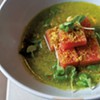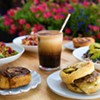Published November 8, 2006 at 2:28 p.m.
It's quarter-of-eight in the morning. Could I really be too late for breakfast? The cafeteria is locked when I descend the conference-center stairs to the double doors. Through dingy windows I see people with plates and plastic cups sitting around rectangular tables with scarred and pitted wood. A few look up at me; nobody moves to let me in.
I know that the kitchen is to my left, but I'm afraid to enter because the voice that emanates from inside sounds more like a drill sergeant's than a maitre d's. The voice issues a crucial directive, and a chorus responds, "Yes, chef!"
But I'm hungry, so I venture inside. After all, I'm not going to let timidity cause me to miss out on the best meal deal in Montpelier. Three times a day, the New England Culinary Institute cafeteria on the Vermont College campus serves up top-notch food at rock-bottom prices. Or so the locals say. . . You don't have to be a student to reap the benefits, but is the hype to be believed? By eating all three meals here today, I intend to find out.
I step tentatively into the kitchen and ask a young man in a floppy hat and chef's whites if they are still serving breakfast, even though I know they must be, given the hour. He doesn't hear me. I repeat myself a couple of times, and finally I yell. He turns and pleasantly informs me that I can order my eggs any way I'd like them.
I look around and detect a dearth of hollandaise sauce. No sautéed mushrooms or asparagus in sight. There are pairs of egg yolks staring up from ceramic ramekins nestled in a huge bowl of ice water, copious quantities of butter and some shredded cheese that appears to be cheddar. So, since I can't really have eggs "any way I'd like them," I order mine scrambled with cheese, then check out the additional fare.
Another chef-to-be stands behind the hot bar looking mildly bored, but he snaps into action when I ask him for a pancake, a few pieces of roasted potato, and some bacon. Placing my dish on a scratched tray next to some wimpy dining hall cutlery, I wait for the scram to arrive. An omelet appears.
"Here are your eggs," he declares.
"But I ordered mine scrambled. This must belong to someone else," I reply.
"I think this is yours. It's kind of a 'flat-style' scramble."
"Uh, OK."
I grab the plate, add it to my tray and turn to look at the beverages: the standard cafeteria selection of coffee, tea, cranberry or orange juice, soda or water. My cup smells like chlorine, less so when filled with a combo of cran and orange.
One member of the kitchen brigade bustles in looking for an omelet with cheese. I hand it over and wait for my eggs, which are appropriately scrambled-looking when they arrive. I shell out a bargain $4.50 for my food and walk towards an empty table at the back of the cafeteria, feeling much more like an awkward high school kid than a fully employed 28-year-old.
The verdict on breakfast is that it's passable but not great. The eggs taste rich and pleasant, and the bacon is neither too chewy nor too crunchy, but the pancake is a bit tough - probably the result of over-beating - and the potatoes are well browned but bland. Feeling unsatisfied, I head back into the kitchen for some fruit salad. "Of course you can, hon," says the woman at the register. "It's all-you-can-eat." The cantaloupe and watermelon taste fine, but the honeydew is rock-hard and flavorless.
*********
Montpelier is just coming to life as I head down the hill that leads downtown from campus. Four hours later, the steep climb back up helps me work up an appetite for lunch. As I stride more confidently into the kitchen, I notice the lackadaisical air that accompanied breakfast service is gone. Students zip around the kitchen purposefully, and a pair stand in front of the hot food trolley plopping food onto people's plates.
I point out the items I want and pay $6.50 for my heaping pile of food. The cafeteria, which was half-empty at breakfast, is almost completely full. The group is diverse - an impeccably dressed woman in her forties with a syrupy Southern accent is in deep conversation with a young African-American man sporting dreads and with a woman who is surely someone's grandma. Another table is full of NECI students, who skillfully analyze the meal.
Before I attempt to do the same, I scope out the soup and salad bar. Although the greens at the bottom of the lettuce bowl are swimming in a puddle of water, some of the options are impressive; I construct a salad out of greens, walnuts, blue cheese and sun-dried tomatoes. On the way back to my table, I dip out a ladleful of beef-noodle soup.
The soup is pleasant and homemade-tasting, the beets are perfectly cooked, and I enjoy the salad. I also love the eggplant topped with spinach and chunky tomato sauce, but the slab of tofu perched on top activates my "lazy vegetarian cooking" alarm. Every non-carnivore I know gets frustrated when chefs take a perfectly lovely veggie dish and crush it under the weight of plain tofu. Perhaps a complementary, well-seasoned but separate tofu dish would be a better way to ensure that non-flesh protein is available to everybody?
Other than the tofu, and some green beans with sautéed onions that approximate the flavor of the Atlantic, my lunch is a perfectly enjoyable experience and is totally worth the money. A woman sitting at the next table exclaims over the chicken and biscuits - the latter are perfectly buttery and flaky - and is also thrilled that green beans are on the menu. She says she wishes they would serve hot green veggies all the time.
At around 1:30, the tired students who arrived here at 5 a.m. to make breakfast start to shuffle out, as a fresh batch comes in to begin prepping for dinner. It's still three-and-a-half hours until my next meal, but I've already walked up Montpelier's huge hill twice, so I decide to stay in my metal and torn-blue-vinyl chair and wait. Since making the meals here is part of a NECI class, I figure that I might even learn something while I sit.
It's not long before Chef Instructor Justin Turcotte, formerly of Chez Panisse in Berkeley, sits down with his eight students to work out the menu for tonight's dinner. They expect about 155 people to show up. I happily prepare to eavesdrop.
Two main dishes are selected based on the availability of ingredients. The meat dish will be burgundy-braised short ribs; the meatless entrée will be battered and fried eggplant with pesto and tomatoes. Even though I'm still full, my mouth begins to water at the thought of fatty, wine-flavored ribs.
Selecting sides gets a little more complicated. Turcotte suggests potato and celeriac purée, but one of the young men responsible for tonight's starch dish isn't a fan of celeriac. "What about a perfect, classic mashed?" asks Turcotte. "But we just had Dijon mashed last night," the student counters. They all agree on roasted potatoes with rosemary.
But what will they do with the rejected celeriac? The solution is to include it in a roasted vegetable medley along with carrots and sweet potatoes. A Greek salad will take care of the greens requirement, and help to use up a box of cucumbers that have been hanging out in the walk-in. After a brief debate about whether the anchovies should be in the salad dressing or on the side, the students head to the kitchen to begin their prep work.
I corner Turcotte before he can follow them to the kitchen, intent on learning more about his class, called "The History and Flavor of Culture." He explains that each NECI class lasts only two and a half weeks, and this is just the second day of a new cycle. This means that the students who were making breakfast and lunch this morning have only done so one other time - that may explain some of the minor glitches and the simplicity of the food.
As the students work their way through the "History and Flavor" class, they learn how to pick apart information about a culture in order to better understand its cuisine. Turcotte likes to cover at least six different cuisines in his class - Cuban, French, Indian and Italian are all on his list this time around.
But because these students are all first-years, they also spend a lot of time working on basics such as knife skills and cooking techniques. As the students improve these throughout the class, the food gets more complex. The students also rotate through the different kitchen "stations" to learn how each one works. The woman who preps the salad-bar veggies tonight might bake dessert tomorrow; the youth who's baking tonight might end up responsible for the main course.
My plate is piled with food by the time I get back to my usual table - all for just $8.25. The celeriac blend and the potatoes are perfectly roasted, the eggplant is crisp and pairs well with the garlicky pesto and tomatoes that top it, and the ribs are delightful. My only complaint about dinner is that there are no sharp knives available to cut the meat. I have to pick up my rib and, by the time I'm done, there's as much sauce on me as on my plate. Longer braising time would have rendered the meat tender enough for a butter knife, but with only five hours to plan and prepare an entire meal, that just wasn't possible.
Sated, I walk out into the fresh air and Halloween darkness. Despite some overlaps - eggplant for both lunch and dinner, potatoes at every meal - almost any college student would have been thrilled to eat the food I got to try today. It was fresh, tasty and, in some cases, locally grown. With jack-o'-lanterns lighting my way, I head back downtown, where NECI runs three other, pricier eating establishments. In the Capital City, it pays - platefuls - to go the distance.
More By This Author
Speaking of Food
-

Q&A: Howard Fisher Delivers Meals on Wheels With a Side of Good Cheer
Dec 20, 2023 -

Video: Howard Fisher Delivers Meals on Wheels
Dec 14, 2023 -

Q&A: Alexis Dexter Rescued 57 Shelter Cats During the July Flood
Sep 13, 2023 -

Video: Two Months After the Flood, Alexis Dexter Rebuilds Kitty Korner Café in Barre and Continues to Rescue Cats
Sep 7, 2023 -

Video: Saying Goodbye to Burlington’s Penny Cluse Café
Nov 17, 2022 - More »
Comments
Comments are closed.
From 2014-2020, Seven Days allowed readers to comment on all stories posted on our website. While we've appreciated the suggestions and insights, right now Seven Days is prioritizing our core mission — producing high-quality, responsible local journalism — over moderating online debates between readers.
To criticize, correct or praise our reporting, please send us a letter to the editor or send us a tip. We’ll check it out and report the results.
Online comments may return when we have better tech tools for managing them. Thanks for reading.











































